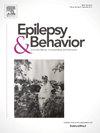难治性癫痫进展:通过分类和回归树分析进行机器学习分析。
IF 2.3
3区 医学
Q2 BEHAVIORAL SCIENCES
引用次数: 0
摘要
背景和目的:利用机器学习技术确定难治性癫痫状态(RSE)进展的预测因素:分析对象包括在摩德纳学术医院登记的连续 9 年间年龄≥ 14 岁的 SE 患者。我们利用逻辑回归和分类与回归树分析(CART)的机器学习分析方法评估了发展为 RSE 的风险,以建立发展为 RSE 的预测模型:研究共纳入了 705 名 SE 患者,其中 33%(233/705)发展为 RSE。进展为 RSE 是 30 天死亡率的独立风险因素,根据之前确定的可能的单变量混杂因素调整后的 OR 为 4.086(CI 95 % 2.390-6.985;P 结论:决策树分析提供了一个有意义的预测模型:决策树分析提供了一种有意义的风险分层方法,其依据是在 SE 首次评估时很容易获得的几个变量:治疗前的意识、病因和严重脑电图模式。必须将 CART 模型视为在单个受试者水平上对 RSE 进行分层的潜在新方法,值得进一步探索和验证。本文章由计算机程序翻译,如有差异,请以英文原文为准。
Progression to refractory status epilepticus: A machine learning analysis by means of classification and regression tree analysis
Background and Objectives
to identify predictors of progression to refractory status epilepticus (RSE) using a machine learning technique.
Methods
Consecutive patients aged ≥ 14 years with SE registered in a 9-years period at Modena Academic Hospital were included in the analysis. We evaluated the risk of progression to RSE using logistic regression and a machine learning analysis by means of classification and regression tree analysis (CART) to develop a predictive model of progression to RSE.
Results
705 patients with SE were included in the study; of those, 33 % (233/705) evolved to RSE. The progression to RSE was an independent risk factor for 30-day mortality, with an OR adjusted for previously identified possible univariate confounders of 4.086 (CI 95 % 2.390–6.985; p < 0.001). According to CART the most important variable predicting evolution to RSE was the impaired consciousness before treatment, followed by acute symptomatic hypoxic etiology and periodic EEG patterns. The decision tree identified 14 nodes with a risk of evolution to RSE ranging from 1.5 % to 90.8 %. The overall percentage of success in classifying patients of the decision tree was 79.4 %; the percentage of accurate prediction was high, 94.1 %, for those patients not progressing to RSE and moderate, 49.8 %, for patients evolving to RSE.
Conclusions
Decision-tree analysis provided a meaningful risk stratification based on few variables that are easily obtained at SE first evaluation: consciousness before treatment, etiology, and severe EEG patterns. CART models must be viewed as potential new method for the stratification RSE at single subject level deserving further exploration and validation.
求助全文
通过发布文献求助,成功后即可免费获取论文全文。
去求助
来源期刊

Epilepsy & Behavior
医学-行为科学
CiteScore
5.40
自引率
15.40%
发文量
385
审稿时长
43 days
期刊介绍:
Epilepsy & Behavior is the fastest-growing international journal uniquely devoted to the rapid dissemination of the most current information available on the behavioral aspects of seizures and epilepsy.
Epilepsy & Behavior presents original peer-reviewed articles based on laboratory and clinical research. Topics are drawn from a variety of fields, including clinical neurology, neurosurgery, neuropsychiatry, neuropsychology, neurophysiology, neuropharmacology, and neuroimaging.
From September 2012 Epilepsy & Behavior stopped accepting Case Reports for publication in the journal. From this date authors who submit to Epilepsy & Behavior will be offered a transfer or asked to resubmit their Case Reports to its new sister journal, Epilepsy & Behavior Case Reports.
 求助内容:
求助内容: 应助结果提醒方式:
应助结果提醒方式:


